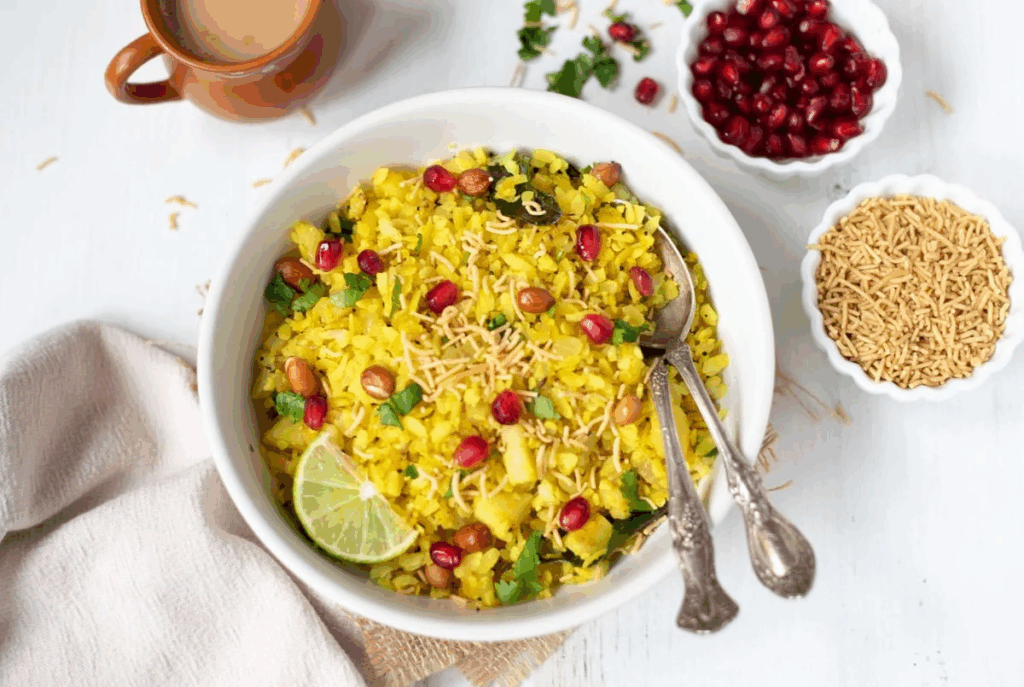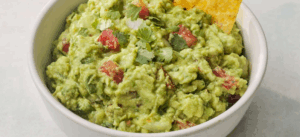How to Prepare Indian Poha Breakfast

Poha was one of the first Indian breakfasts I mastered in a professional kitchen. It’s quick, flavorful, and endlessly adaptable—exactly the kind of dish you fall in love with. I still remember the steam rising from my first batch, scented with curry leaves, mustard seeds, and lemon juice. Whether you’re cooking for yourself or hosting a weekend brunch, I’ll show you how to make Poha taste like home.
- What Is Poha and Why It Matters in Indian Breakfasts
- Choosing the Right Type of Poha for Your Recipe
- Basic Ingredients You’ll Need for Authentic Poha
- Estimated Cook Times for Different Methods
- How to Rinse and Soften Poha Properly Without Making It Mushy
- How to Cook Classic Poha on the Stovetop
- Variations of Poha: Regional and Creative Twists
- Cooking Poha in a Microwave, Oven, and Slow Cooker
- Common Mistakes to Avoid When Making Poha
- Nutritional Value and Health Benefits of Poha
- Timing Table: When to Serve Poha and How Long to Prepare
- Best Pairings: Drinks and Sides That Complement Poha
- How to Store Leftover Poha Without Losing Texture
- Poha for Kids and Picky Eaters
- My Tips for Making Poha in Big Batches
- Why Poha Is Perfect for Beginners in Indian Cooking
- FAQ – Frequently Asked Questions About Indian Poha

What Is Poha and Why It Matters in Indian Breakfasts
Poha, also called flattened rice, is a staple across many parts of India, especially in Maharashtra, Madhya Pradesh, and Gujarat. It’s made from dehusked rice that’s parboiled, then rolled into thin flakes. These flakes soak up flavor beautifully without becoming soggy, which makes them perfect for quick meals.
What makes Poha special in my eyes is its balance: it’s light yet satisfying, mildly spiced yet complex, and adaptable for both weekday breakfasts and festive brunches. From my years as a chef, I can tell you Poha is one of the few dishes that never fails to comfort. It’s also often served alongside chutneys, pickles, or even Idli and sambar on South Indian breakfast spreads.
Choosing the Right Type of Poha for Your Recipe
There are different types of Poha flakes available, and your dish will only be as good as the one you choose. You’ll find three main types: thin, medium, and thick. For breakfast-style Poha, I always go with thick flakes, especially when I’m adding vegetables or nuts. They stay fluffy and don’t clump together.
Thin Poha is better for quick dry snacks, but if you use it in traditional recipes, it tends to disintegrate during soaking. In my own kitchen, I always rinse the thick Poha in a colander, just until it softens—never soaking it in water, which makes it mushy.
If you’re looking for gluten-free breakfast ideas or lighter alternatives to grains, Poha is a brilliant option. It’s gentle on the stomach, which is why I often recommend it to clients who are recovering from illness or adjusting to Indian food.

Basic Ingredients You’ll Need for Authentic Poha
Here’s what I always keep on hand when making classic Poha. The beauty lies in simplicity and freshness:
- Poha (flattened rice) – thick variety
- Onions – finely chopped, sautéed until golden
- Green chilies – slit or finely chopped
- Mustard seeds – for that essential crackle in oil
- Curry leaves – fresh if possible, for aroma
- Turmeric – a pinch gives it that signature yellow hue
- Salt and sugar – to balance flavor
- Lemon juice – added at the end for brightness
- Peanuts – dry-roasted or fried, for texture
- Fresh coriander leaves – for garnish
Some regions also include potatoes, carrots, or peas. I often play with vegetables depending on the season or what I have available. If you’re already prepping vegetables for Korma curry, it’s easy to set a handful aside for Poha.
Estimated Cook Times for Different Methods
| Cooking Method | Prep Time | Cook Time | Total Time | Texture Outcome |
| Stovetop (standard) | 5 min | 10 min | 15 min | Fluffy and aromatic |
| Microwave | 4 min | 6 min | 10 min | Slightly drier |
| Oven (bake-style) | 10 min | 15 min | 25 min | Crispy edges |
| Slow cooker | 5 min | 45–60 min | ~1 hour | Soft and warm |
Personally, I prefer the stovetop for speed and flavor, but when hosting brunch, I use the oven to keep it warm and crisp for longer. When traveling or meal-prepping in bulk, slow cooker Poha holds up surprisingly well—it’s comforting and requires no watching.
How to Rinse and Soften Poha Properly Without Making It Mushy
This is where most first-timers go wrong, but from my experience, the secret lies in how you rinse. I place the thick Poha in a wide mesh colander and run cold water over it for 10–15 seconds. I toss gently with my fingers, just until it’s soft enough to break when pressed between two fingers.
I never soak Poha in a bowl of water—this makes it soggy and lifeless. After rinsing, I leave it in the colander to rest for 5 minutes, which lets the excess water drain completely. A sprinkle of turmeric and salt at this stage helps it absorb flavor right from the start.
How to Cook Classic Poha on the Stovetop
This is my go-to method, especially when I want breakfast ready in under 15 minutes. I heat oil in a wide non-stick pan, add mustard seeds, and let them crackle. Then go in the green chilies and curry leaves—your kitchen will smell amazing at this point.
I add chopped onions and sauté until golden. Peanuts come next, and I toast them until crunchy. Finally, I stir in the pre-rinsed Poha, mix everything gently, cover, and cook on low heat for 2–3 minutes. At the end, I add lemon juice and chopped coriander. It’s vibrant, savory, and light.
Some mornings, I like pairing this with Indian Pulao rice to create a North–West fusion brunch.

Variations of Poha: Regional and Creative Twists
One of the reasons I love Poha is how different regions have their own takes on it—and I’ve tried many in my travels.
- Kanda Poha (Maharashtra): Heavy on onions and often topped with sev.
- Batata Poha (Gujarat): Includes diced potatoes and a touch of sugar for balance.
- Indori Poha (Madhya Pradesh): Served with jalebi, spicy sev, and a hint of fennel—yes, sweet and spicy together!
- Kolkata-style Poha: Slightly wetter and includes grated coconut, which I personally adore.
For creative spins, I’ve made Poha with sautéed spinach, corn, even bell peppers. Sometimes I fold in scrambled paneer or tofu for protein, or serve it as a side with rich dishes like Korma curry to balance out the richness.
Cooking Poha in a Microwave, Oven, and Slow Cooker
I often experiment with alternate cooking methods depending on the setting—home, travel, or events.
Microwave:
I mix all ingredients (except lemon and coriander) in a microwave-safe bowl, cover it with a plate, and heat on high for 3–4 minutes. Stir once halfway through. It works well when I’m in a rush.
Oven:
I preheat to 180°C (350°F), spread the Poha mix in a greased baking dish, cover with foil, and bake for 15 minutes. Then I uncover it for the last 5 minutes to get crispy bits—great for brunch tables.
Slow Cooker:
This is my favorite method when I’m hosting. I toss the cooked onion-chili base and pre-rinsed Poha into the slow cooker, drizzle with lemon juice, and cook on low for 45–60 minutes. It holds beautifully without drying out.

Common Mistakes to Avoid When Making Poha
Even experienced cooks can make mistakes with Poha—it’s a deceptively simple dish. One of the most common issues I’ve seen in home kitchens is over-soaking the flakes. The goal is softened Poha, not paste.
Another mistake is skipping the tempering stage. Those sizzling mustard seeds and curry leaves are essential—they infuse the oil with flavor, which coats every grain. Adding vegetables with too much water also ruins the texture. If I add tomatoes, for example, I cook them until almost dry to avoid excess moisture.
Using the wrong variety of Poha is another pitfall. I once tested thin Poha for a catering event out of necessity, and the results were disappointing—it broke apart in the pan.
Nutritional Value and Health Benefits of Poha
From a chef’s standpoint, Poha is a gift to any health-conscious meal plan. It’s low in fat, naturally gluten-free, and gentle on digestion. I’ve often recommended it to clients needing easy breakfasts during recovery or detox.
Poha is rich in iron, especially if processed the traditional way in India. Adding lemon juice at the end not only brightens the flavor but also boosts iron absorption. It’s also easy to enrich: I sometimes stir in sautéed spinach, grated carrots, or green peas to add vitamins and fiber.
And let’s not forget—it’s a great alternative to heavier grain dishes, especially when you’ve had a spicy dinner like Korma curry the night before.
Timing Table: When to Serve Poha and How Long to Prepare
| Occasion | Best Serving Time | Prep Time | Active Cook Time | Total Time |
| Weekday breakfast | 7–9 AM | 5 min | 10 min | 15 min |
| Brunch with guests | 10–11:30 AM | 10 min | 15 min | 25 min |
| Light evening meal | 6–7 PM | 5 min | 10 min | 15 min |
| Potluck or travel snack | Anytime (warm or cold) | 10 min | 15 min | 25 min |
I’ve served Poha at everything from morning yoga retreats to evening gatherings. Its adaptability across the clock is what keeps it in my regular rotation.
Best Pairings: Drinks and Sides That Complement Poha
When I serve Poha in a full Indian breakfast spread, I like to include something mild and cooling, like coconut chutney or curd (yogurt). It also pairs beautifully with masala chai—the spices in the tea echo the mustard and curry leaf aroma of the Poha.
Sometimes, for weekend brunches, I plate it alongside small portions of Idli and sambar. The combination of textures—fluffy rice cakes, spicy lentil soup, and soft Poha—is always a hit with guests.
If I’m serving Poha as part of a multi-course meal, I offer it as a side to spicier or richer mains, like stuffed paratha or chickpea curry. It resets the palate and adds balance.
How to Store Leftover Poha Without Losing Texture
On busy days, I often make a double batch of Poha to enjoy later. From experience, it holds up well for about 1–2 days in the refrigerator. I store it in an airtight glass container, lined with a paper towel at the base to catch moisture.
When reheating, I sprinkle a tablespoon of water and cover it loosely before microwaving. If using the stovetop, I add just a few drops of oil and stir gently over low heat. I never recommend freezing Poha—it turns gummy after thawing, which ruins the soft-yet-flaky texture we work so hard to achieve.
Poha for Kids and Picky Eaters
I’ve cooked for families where children turn their noses up at anything green or unfamiliar. So when I make Poha for kids, I get creative. I dice carrots into tiny cubes, add sweet corn, and even a few cashews. I keep the chili minimal or skip it entirely, and substitute curry leaves with a touch of ghee for aroma.
Sometimes I shape warm Poha into little patties and serve it like hash browns. This wins over even the fussiest eaters. I’ve also paired it with mild dal or yogurt to make it feel more familiar for first-timers.
My Tips for Making Poha in Big Batches
For catering gigs and weekend brunches, I’ve scaled Poha up to serve 30–50 people. What I’ve learned is: don’t try to cook it all at once in one giant pan. I prepare the tempering in large quantities, but I split the Poha into manageable batches.
Rinsing in bulk is tricky, so I use a large perforated pasta pot to gently rinse and drain. I also make sure to undercook it slightly if it will sit on a buffet line—it will continue to steam and stay soft for hours in insulated pans.
Why Poha Is Perfect for Beginners in Indian Cooking
If you’re new to Indian cuisine, Poha is one of the best dishes to start with. There’s no need to handle raw spices or long simmering times. Everything cooks in one pan, and the ingredients are widely available. I’ve even taught it to students using just pantry basics from non-Indian stores.
It’s quick, forgiving, and endlessly adaptable. Once you get the hang of balancing turmeric, salt, and citrus, you’ll see how simple it is to customize the flavor. And if you’re exploring more breakfast options, Poha is a great bridge to dishes like How to make Indian Pulao rice or even savory pancakes.
FAQ – Frequently Asked Questions About Indian Poha
What type of Poha should I buy?
On my own experience, thick Poha is best—it holds its shape and gives that satisfying bite. Thin Poha turns to mush too quickly.
Can I use red rice Poha instead of white?
Yes, I’ve tried red rice flakes—they’re more fibrous and have a deeper flavor. Great if you want a more earthy version.
Is Poha considered gluten-free?
Yes, naturally. I’ve served it to gluten-sensitive clients with no issues.
Can I add protein like chicken or egg?
I’ve stirred in scrambled eggs or served it with grilled chicken. It works well but keep spices simple.
What if my Poha turned out dry?
Try sprinkling a little warm water and covering the pan for 2 minutes. I’ve saved many batches this way.
Is lemon juice necessary?
From my kitchen tests, yes—it brings brightness and helps with iron absorption too.
Can I make Poha the night before?
You can, but I wouldn’t fully cook it. Prepare the tempering and rinse Poha separately. Combine fresh in the morning.
Can I skip mustard seeds and curry leaves?
You can, but the flavor won’t be as authentic. I once made it with just cumin and garlic—it was decent, but not the same.
How do I reduce oil in the recipe?
I’ve made versions with just a teaspoon of oil. Use a non-stick pan and dry-roast peanuts separately.
Can Poha be served cold?
Indori Poha is sometimes eaten at room temp. I’ve packed it cold for train journeys—it holds up.
What’s the best side for Poha?
From my experience, plain yogurt or chai makes it complete.
Can I use olive oil instead of traditional Indian oils?
Yes, but go light. I tried it once—it was mild but slightly altered the taste.
Is this dish spicy?
It can be, but I control spice by adjusting chilies. For guests, I always make a mild version.
Can I prepare Poha in advance for a party?
Yes. Keep it in a warm container and add lemon juice and herbs just before serving.
Is Poha suitable for a diabetic diet?
I’ve prepared it for clients managing blood sugar. Stick to small portions and avoid adding potatoes.




Post Comment